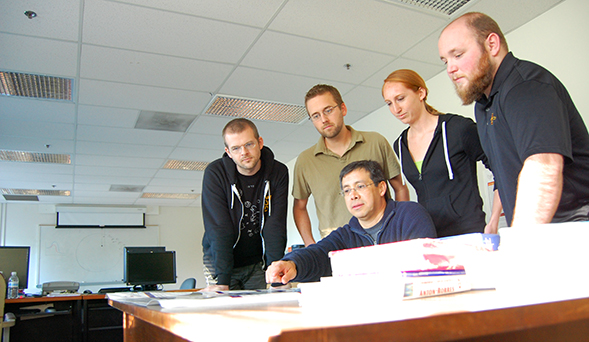A Man for All Sensors
Antonio Palacios, professor of mathematics, is working to build sensors that rival the perfection of the natural world.

At San Diego State University, Antonio Palacios, Ph.D., is working to build sensors that rival the perfection of the natural world.
His research has been supported with more than $2 million in funding from the National Science Foundation, the Army Research Office, the Department of Defense and the Space and Naval Warfare Systems Command (SPAWAR) in San Diego.
Concept into reality
A theoretical mathematician by training, Palacios has turned concept into reality by exploiting the symmetry of interconnected objects—in this case, sensors—to enhance their effectiveness.
“Mathematics comes into play in how you couple the sensors and change their orientation,” Palacios explained.
His research has numerous practical applications, particularly for the U.S. military. Together with SPAWAR scientists, Palacios is working on a new generation of highly sensitive, low-cost magnetic sensors to detect weapons and terrorist targets. Another project, an antenna system prototype, is a model for communications systems that will be not only stealthier, but also able to monitor multiple frequencies.
Prolific patent-holder
Palacios holds six patents, an unusually high number for an individual, but exceptionally so for a mathematician. Also exceptional is the breadth of his research. Palacios’ patents have applications in the fields of engineering, physics and mathematics.
Three additional patents are under review by the government and another two are in preparation, he said.
From SDSU to SPAWAR
Palacios’ work with SPAWAR has advanced his own career and also that of his master’s and Ph.D. students. Through Palacios, several have secured internships with SPAWAR. Two students—Patrick Longhini and Susan Berggren—are currently employed with SPAWAR as research scientists.
Longhini also assisted Palacios in organizing three international conferences for nonlinear dynamics researchers in 2007, 2010 and 2012.
“Most Ph.D. students build prototypes, but they rarely get to see their projects actualized,” Longhini said. “At SDSU, working with Antonio and SPAWAR, I was able to take my Ph.D. concept from idea to actualization. Devices based on my work have been fabricated and are now used in the field.”


